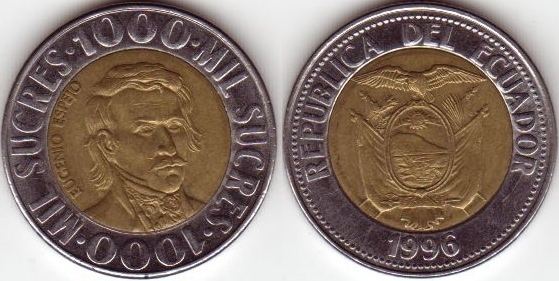Code ECS Exponent 0 Plural sucres | Number 218 | |
 | ||
1000 sucres, 1996 Ecuadorian Sucre notes used in the last years before dollarization. | ||
The sucre was the currency of Ecuador between 1884 and 2000. Its ISO code was ECS and it was subdivided into 10 decimos or 100 centavos. The sucre was named after Antonio José de Sucre.
Contents
History
The Ecuadorian peso was renamed sucre on March 22, 1884, and firmly placed on the silver standard. The sucre was defined as 22.5 g fine silver (equivalent to 5 francs of the Latin Monetary Union.) Substandard coins were withdrawn from 1887 to 1892, with only high-quality silver remaining in circulation.
The fall in the international price of silver accelerated in the 1890s. On November 3, 1898, Ecuador switched to the gold standard, with the sucre defined as 732.224 mg fine gold (equivalent to 2 shillings sterling).
Like so many other currencies, the sucre became inconvertible shortly after World War I began in 1914. The exchange rate kept falling, despite extensive measures to support it. It was finally stabilized during 1926, and on March 4, 1927 Ecuador went on the gold exchange standard, with the sucre equal to 300.933 mg fine gold or US$0.20 (a devaluation of 58.8%).
The gold exchange standard was suspended February 8, 1932. Exchange controls were adopted April 30 and the official rate was fixed at 5.95 (buying) per U.S. dollar. After the price of silver rose above the nominal value of most silver coins in the 1930s, Ecuador embargoed the export of silver (May 17, 1935). This was followed by numerous adjustments to the foreign exchange system as the sucre continued to depreciate. Foreign exchange controls were finally lifted in September 1937 and the official rate was set at 13.5 sucre per U.S. dollar. The sucre was devalued to 14.77 sucre per dollar on June 4, 1940 and exchange controls were reimposed. The official rate became 14 in 1942 and 13.5 in 1944.
Parity was registered with the International Monetary Fund on December 18, 1946 at 65.827 mg fine gold (13.5 per US$), but a system of multiple exchange rates was adopted in 1947. The sucre's IMF par was devalued to 15 sucre per dollar in 1950, to 18 in 1961, and to 25 in 1970.
The sucre maintained a fairly stable exchange rate against the U.S. dollar until 1983, when it was devalued to 42 per dollar and a crawling peg was adopted. Depreciation gained momentum and the free market rate was over 800 per dollar by 1990 and almost 3000 in 1995.
The sucre lost 67% of its foreign exchange value during 1999, then in one week nosedived 17%, ending at 25,000 sucre = 1 U.S. dollar on January 7, 2000. On January 9, President Jamil Mahuad announced that the US dollar would be adopted as Ecuador's official currency. The US dollar became legal tender in Ecuador March 13, 2000, and sucre notes ceased being legal tender on September 11. Sucre notes remained exchangeable at Banco Central until March 30, 2001, at 25,000 sucres per dollar.
Coins
In 1884, cupro-nickel ½ and 1 centavo, and ½ decimo, and silver 1 and 2 decimos, ½ and 1 sucre coins were introduced. Centavo coins minted as subdivisions of the peso continued to circulate after the introduction of the sucre. Copper replaced cupronickel in the ½ and 1 centavo in 1890, while silver ½ decimo coins were introduced in 1893. The 10-centavo coin was called a real, with the 5-centavo coin known as a medio (meaning half). Gold 10 sucres were issued in 1899 and 1900.
In 1909, cupro-nickel ½, 1, 2 and 5 centavo coins were issued, followed by 2½ centavos in 1917 and 10 centavos in 1918. Production of silver coins was suspended in 1916. In 1928, a new coinage was introduced consisting of a bronze 1 centavo, nickel 2½, 5 and 10 centavos, silver 50 centavos, 1 and 2 sucres, and gold 1 condor. The 1 sucre coin was reduced from 25 grams of 90% silver to 5 grams of 72% silver, while the condor, worth 25 sucres, was equivalent to a U.S. quarter eagle coin. The new coins were dubbed Ayoras after the president, Isidro Ayora. In 1937, nickel 20 centavo and 1 sucre coins were introduced, followed by brass 5, 10 and 20 centavos in 1942 and silver 5 sucres in 1943. The last silver coins (2 and 5 sucres) were struck in 1944.
Cupro-nickel replaced brass in the 5, 10 and 20 centavos in 1946, with a cupro-nickel 1 sucre introduced in 1959. 1959 also saw the introduction of nickel-clad steel 20 centavos, with this metal replacing others in the 5, 10 and 50 centavos and 1 sucre between 1963 and 1970.
In 1988, nickel-clad steel coins for 10, 20 and 50 sucres were introduced, while high inflation in the 1990s lead to bi-metallic coins for 100, 500 and 1000 sucres being introduced between 1995 and 1996.
Historic exchange rates
Sucres per U.S. Dollar:
